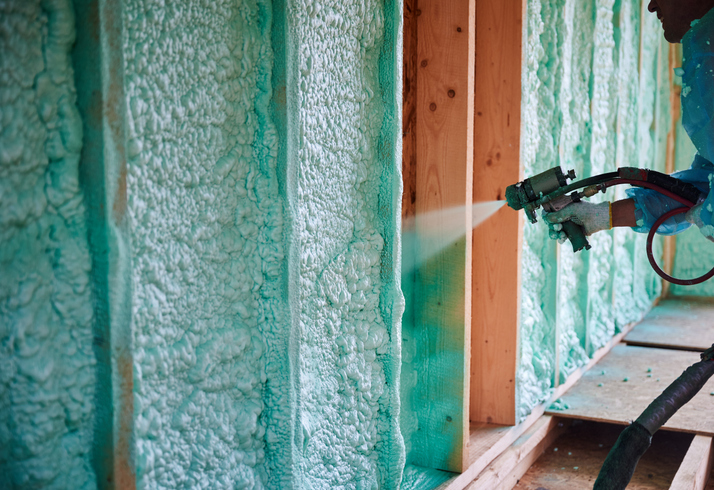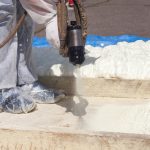Is Open-Cell Spray Foam Right for Your Application?
Whether you’re constructing a commercial or residential property, you’ll have to decide on a type of insulation for the project. With so many options to choose from — fiberglass, cellulose, open-cell spray foam, or closed-cell spray foam — it can be difficult to discern what’s right for you. Here, we’ll help you understand what open-cell spray foam is and why it’s likely the right choice for your residential or commercial project. Let’s dive in.
What is Open-Cell Spray Foam?
Open-cell spray foam is a type of polyurethane foam that expands upon application. It’s made up of polyurethane and a blowing agent, which creates a porous structure filled with tiny air bubbles. Its characteristics make it perfect for insulation purposes, as it can fill even the smallest gaps and irregular spaces within walls, ceilings, and floors.
This foam is also perfect for insulation because of its air permeability characteristics. The open-cell structure allows air to pass through the material. As such, this makes open-cell foam advantageous in applications like roofing. Additionally, the permeability helps prevent moisture buildup and promotes ventilation, which reduces the risk of condensation and mold growth.
Benefits of Open-Cell Spray Foam
Promotes Energy Efficiency
Open-cell spray foam has a great R-value, usually around 3.5 per inch. That means it’s great at providing thermal insulating and air barrier properties. Moreover, the foam’s expansive nature enables it to effectively seal cracks and gaps, reducing air leakage and enhancing energy efficiency.
Excellent Insulation
While the R-value might not be as high as other options, it is a more cost-effective solution that provides great insulation for residential and commercial properties.
Great Sound Absorption
Because this foam is porous, it absorbs sound waves. As such, it’s a great option for reducing ambient noise within residential and commercial buildings.
How Does it Compare to Other Options?
As mentioned above, there are other common types of insulation, including fiberglass, cellulose, and closed-cell spray foam. How does open-cell foam compare to these?
Fiberglass
Fiberglass is a lightweight composite material commonly used for insulation purposes. It’s made of a plastic matrix reinforced by small glass fibers. It can be compressed into batts or blown directly onto the area you want to insulate.
Fiberglass and open-cell foam usually cost about the same, though that will depend on several variables. However, open-cell foam usually has a higher R-value, which means it provides better thermal resistance. Therefore, it offers improved energy efficiency and lower heating and cooling costs.
Additionally, open-cell foam is less prone to moisture absorption, which reduces the risk of mold and mildew. It’s also more durable and can maintain its effectiveness far longer than fiberglass.
Cellulose
Cellulose is made from recycled paper fibers, like newsprint, cardboard, or other paper products. The fibers are usually treated with fire-retardant chemicals like boric acid or ammonium sulfate, ensuring fire resistance. It’s commonly available in loose-fill form, which is blown or poured into cavities using specialized equipment, or in dense-packed form, which is densely packed into walls and other cavities.
Open-cell foam is better than cellulose for the same reasons that it trumps fiberglass. Open-cell foam has a higher R-value, is less prone to moisture absorption, and maintains its effectiveness longer than cellulose.
Closed-Cell Spray Foam
Closed-cell spray foam is similar to its open-cell counterpart. However, the cells are completely closed and packed tightly together. Therefore, it doesn’t have the same permeability that open-cell foam has.
Closed-cell foam has higher R-values, which can further improve energy efficiency. However, it’s much more expensive than open-cell foam. Many construction companies will go with open-cell foam because it provides better sound-dampening qualities and greater flexibility at a lower cost.
Considerations and Limitations for Open-Cell Spray Foam
Though open-cell foam is a popular choice among construction companies, that doesn’t mean it’s without its limitations. This variety of foam can absorb moisture, which can lead to mold growth if not properly installed and maintained. Additionally, you may need to add certain vapor barriers within some climates. Lastly, open-cell foam is prone to compression over time, which may affect its insulation properties. Overall, the open-cell option will still be the best solution for many applications.
How Do You Get Started with Open Cell Spray Foam?
If you think open-cell spray foam is the right choice for your application, you might be wondering how to get started. The first step is to find a reliable polyurethane equipment manufacturer, like Linden Industries. We can provide you with all the equipment you need to install open-cell spray foam in your chosen application successfully. Our helpful team can assist you in choosing the right equipment and mix heads for your needs. What’s more, we can repair any kind of polyurethane processing equipment and machinery, whether it’s Linden or another brand.
Since our inception in 1985, we’ve successfully pioneered many polyurethane innovations as well as refined the tools and equipment used by countless industries. Today, we can design and manufacture all types of polyurethane metering, processing, distribution, and storage systems in-house, while providing service and repair. We’ve helped hundreds of companies solve their polyurethane production needs, and we’d be happy to help you too.
Reach Out to Us Today
Ready to learn more about what we can do for you? Our helpful team is standing by to provide more information.





